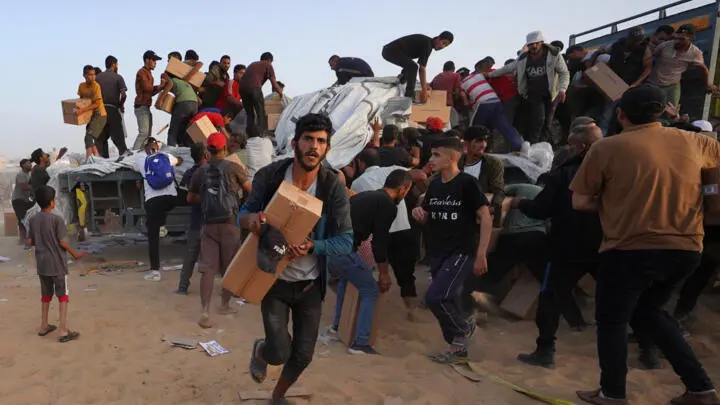Gaza’s Humanitarian Crisis Explodes at a US-Backed Aid Center: In the blistering heat of a war-torn Gaza afternoon, what was meant to be a moment of relief turned into utter chaos. At a U.S.-backed aid distribution center in northern Gaza, thousands of desperate people — hungry, scared, and weary — surged forward, pushing past makeshift barriers and security personnel. For many, this was the last hope for a bag of flour or a bottle of clean water. For others, it was another chapter in an unfolding nightmare.
This isn’t just another aid distribution mishap. It’s a painful reflection of a region teetering on the edge of famine.
“We Were Just Hungry, That’s All”
Rania, a 32-year-old mother of four, clutched her youngest tightly as she described what she saw. “It wasn’t looting. It was desperation. We were just hungry, that’s all.”
She had walked nearly 12 kilometers from her shattered neighborhood to the Global Hope for Families (GHF) distribution site — a U.S.-supported humanitarian center trying to bring relief to Gaza’s war-ravaged north. Like many others, she arrived long before sunrise, hoping to be among the first in line. But as the sun climbed, so did the crowd. Tensions simmered. And then, everything unraveled.
Eyewitnesses reported that as trucks arrived, the crowd broke past fences and security forces. Volunteers were overwhelmed. Food, instead of being distributed calmly, was grabbed in a frenzy. Some fell. Some were trampled. “People didn’t want to fight,” Rania added, “they just didn’t want their children to go another day without eating.”
Aid Turned Mayhem – US-Backed Aid Center
The GHF, with support from the United States, had been attempting to scale up food delivery in Gaza after months of violence and blockades that left tens of thousands without access to essentials. The group had hoped that the center would provide a lifeline — a safe and organized distribution point in the heart of a crumbling region.
But what unfolded proved the situation on the ground had already surpassed a breaking point.
Photos and videos captured show massive crowds swarming supply trucks, climbing over metal barriers, shouting, crying. Aid workers can be seen trying to calm people, urging them to queue. But the need outnumbered the resources — and control slipped away.
An unnamed official from GHF later remarked, “This isn’t about logistics anymore. It’s about human survival. When your child hasn’t eaten in two days, you’re not thinking about order or lines.”
for more read-AL JAZEERA
Starvation in Real Time
The U.N. and World Food Programme have repeatedly warned of an impending famine in Gaza. Hospitals are overwhelmed. Water is scarce. Food markets are ghost towns — either bombed out or empty. And even where food exists, prices have skyrocketed beyond what ordinary families can afford.
Dr. Anwar El-Khatib, who runs a small clinic in Beit Lahia, said they’ve started seeing clear signs of starvation — sunken eyes, rapid weight loss in children, even miscarriages due to malnutrition. “These are not isolated cases. It’s systemic. And it’s deadly.”
He told us, “When you combine war trauma with food insecurity, the result is long-term damage — physical and emotional — especially for children.”

International Aid Struggles to Keep Up
Despite growing global attention, aid agencies are facing enormous hurdles. Border crossings are limited. Convoys are blocked or delayed. And air drops, while symbolically powerful, are only able to feed a fraction of the population in need.
The U.S. has ramped up efforts, backing NGOs like GHF and calling on Israel to ease access for humanitarian convoys. But that’s easier said than done. The ongoing conflict, tight border restrictions, and fear of goods being seized by militant groups make every delivery a high-risk operation.
“Even with full diplomatic support, it’s like threading a needle in a sandstorm,” one senior aid coordinator commented.
When Human Need Defies Protocol-US-Backed Aid Center
Aid distribution, especially in conflict zones, requires a delicate balance of security, fairness, and speed. But in Gaza today, that balance is shattered.
Experts say the chaos seen at the GHF site isn’t surprising. With nearly 2 million people displaced and most infrastructure in ruins, even the most well-intentioned aid plan can quickly unravel without coordination, trust, and safety.
Sami Abu Salem, a freelance journalist based in Gaza, said, “People have lost hope in systems. When every institution around you collapses, and no one seems to be listening, survival becomes the only instinct.”
A Wake-Up Call for the World
The images of people storming aid trucks should not be dismissed as mere disorder. They are, in fact, the most honest mirror of how deep this humanitarian crisis has become. No person — no child — should have to fight for food with bare hands in 2025. Yet here we are.
Governments, donors, and agencies need to rethink not just how aid is delivered, but how global attention is sustained beyond headlines and hashtags.
Because for families in Gaza, this isn’t a political crisis or a media story — it’s life and death.
Final Thoughts
What happened at that distribution center was not just a breakdown of aid logistics. It was the culmination of years of conflict, blockade, and ignored warnings. It was human beings, caught in an impossible storm, doing what they had to — just to eat.
In the coming weeks, more convoys will arrive. More efforts will be made. But unless a ceasefire takes root, unless access is truly opened, and unless the world stops turning away from Gaza’s cries, this will repeat again. And again.
The question isn’t how to restore order. The question is: How many more children must go hungry before we act like they matter?
For more updates and other exciting news, visit our website now!
Join GetRapidnews















